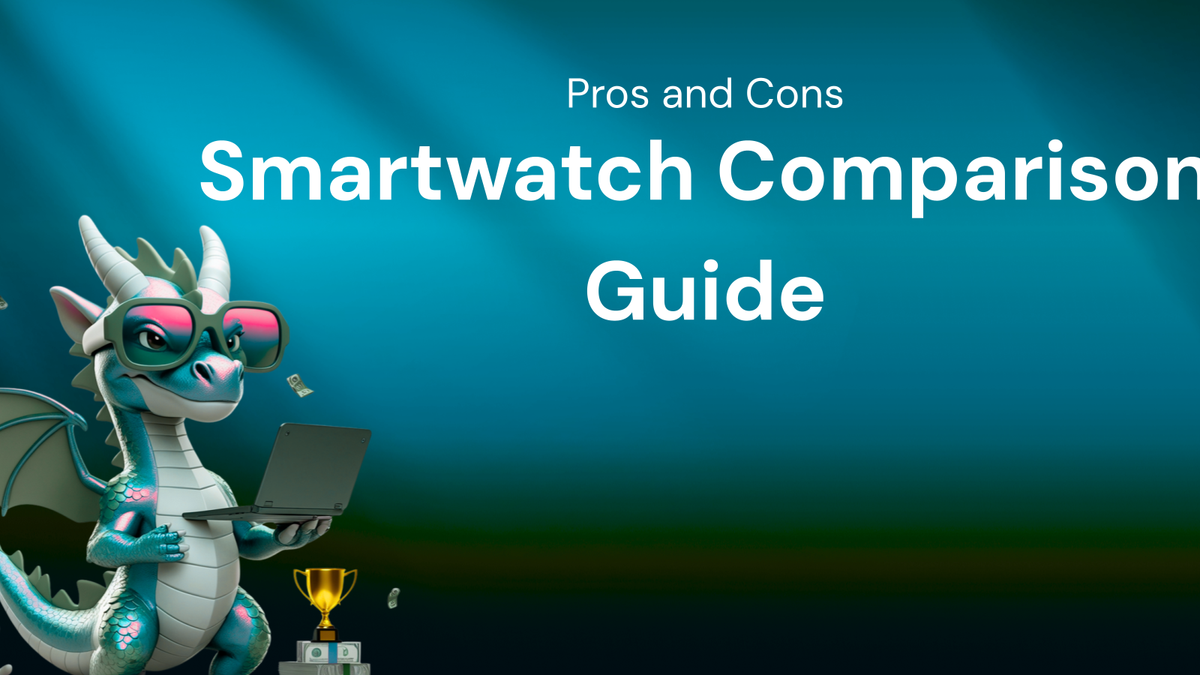Smartwatch Comparison: Pros and Cons Guide

Smartwatch Comparison: A Comprehensive Pros and Cons Guide
Smartwatches have exploded in popularity, evolving from simple notification devices to sophisticated extensions of our smartphones and even powerful standalone tools. With a vast array of brands, models, and features flooding the market, choosing the right smartwatch can feel overwhelming. This guide provides a detailed comparison of smartwatches, weighing the pros and cons to help you make an informed decision based on your needs and priorities.
I. Understanding the Smartwatch Landscape: Categories and Key Features
Before diving into specific models, it's crucial to understand the different categories and key features that define the smartwatch market. Smartwatches can be broadly categorized based on their operating system, functionality, and target audience.
A. Categories of Smartwatches:
- Basic Smartwatches/Fitness Trackers: These devices primarily focus on fitness tracking, providing features like step counting, heart rate monitoring, sleep tracking, and basic notifications. They often have limited app support and may lack advanced features like GPS or cellular connectivity. Examples include Fitbit Inspire series and Xiaomi Mi Bands.
- Mainstream Smartwatches: These smartwatches offer a broader range of features, including notifications, app support, GPS, contactless payments (NFC), and more advanced fitness tracking capabilities. They typically run on established operating systems like watchOS, Wear OS, or Tizen. Examples include Apple Watch Series, Samsung Galaxy Watch series, and Google Pixel Watch.
- Specialized/Outdoor Smartwatches: Designed for specific activities or environments, these smartwatches prioritize durability, GPS accuracy, and specialized sensors for activities like hiking, diving, or aviation. They often feature rugged designs, long battery life, and pre-loaded maps. Examples include Garmin Fenix series, Suunto series, and Casio Pro Trek series.
- Hybrid Smartwatches: These blend the classic aesthetics of traditional analog watches with basic smartwatch features like step tracking and notification alerts. They often have long battery life and a subtle integration of smart features. Examples include Fossil Hybrid Smartwatches and Withings ScanWatch.
B. Key Features to Consider:
- Operating System: The OS determines the user interface, app availability, and compatibility with your smartphone. Key players include:
- watchOS (Apple Watch): Known for its seamless integration with iPhones, user-friendliness, and robust app ecosystem.
- Wear OS (Google): Compatible with both Android and iOS devices, offering a customizable experience and integration with Google services.
- Tizen (Samsung): A proprietary OS from Samsung, known for its efficient performance and intuitive interface.
- Proprietary OS (Fitbit, Garmin, Xiaomi): Typically optimized for fitness tracking and long battery life, with varying levels of app support.
- Fitness Tracking: Consider the accuracy and comprehensiveness of fitness tracking features, including heart rate monitoring, GPS, step counting, sleep tracking, and workout modes. Look for smartwatches that offer personalized insights and data analysis.
- Notifications and Communication: Assess how effectively the smartwatch handles notifications, allows for message replies, and supports phone calls. Some smartwatches offer cellular connectivity for standalone communication.
- App Ecosystem: The availability and quality of apps can significantly enhance the functionality of your smartwatch. Consider the range of apps available for productivity, entertainment, and health management.
- Battery Life: Battery life varies widely depending on the smartwatch model and usage patterns. Factors like GPS use, always-on display, and cellular connectivity can significantly impact battery performance.
- Design and Comfort: Choose a smartwatch with a design that suits your style and a comfortable fit for all-day wear. Consider the size, weight, and materials used in the construction.
- Display Quality: A clear and vibrant display is essential for easy readability in various lighting conditions. Look for smartwatches with AMOLED or LCD displays with high resolution and brightness.
- Connectivity: Ensure the smartwatch supports Bluetooth for connecting to your smartphone and Wi-Fi for independent internet access. Cellular connectivity offers the most freedom but comes with an additional monthly cost.
- Water Resistance: Check the water resistance rating (e.g., ATM, IP rating) to ensure the smartwatch can withstand sweat, rain, or swimming.
- Payment Options: NFC (Near Field Communication) allows for contactless payments using services like Apple Pay, Google Pay, or Samsung Pay.
- Health Features: Some smartwatches offer advanced health features like ECG (electrocardiogram) monitoring, blood oxygen (SpO2) monitoring, fall detection, and irregular heart rhythm notifications.
II. Apple Watch: A Deep Dive
A. Pros:
- Seamless Integration with iPhones: The Apple Watch offers unparalleled integration with iPhones, providing smooth and reliable communication, notification delivery, and data synchronization.
- User-Friendly Interface: watchOS is known for its intuitive and easy-to-navigate interface, making it accessible to users of all technical skill levels.
- Robust App Ecosystem: The Apple Watch has a vast app store with a wide variety of apps for productivity, entertainment, health, and fitness.
- Advanced Health Features: Apple Watch models offer advanced health features like ECG monitoring, blood oxygen (SpO2) monitoring, fall detection, and irregular heart rhythm notifications.
- Excellent Fitness Tracking: The Apple Watch provides accurate and comprehensive fitness tracking, with detailed workout metrics, GPS tracking, and personalized insights.
- Apple Pay Integration: Seamlessly make contactless payments using Apple Pay.
- Strong Resale Value: Apple Watches tend to hold their value well, making them a good investment.
- Family Setup: Allows you to set up and manage Apple Watches for family members who don't have iPhones.
B. Cons:
- Exclusively for iPhone Users: The Apple Watch is only compatible with iPhones, making it a non-starter for Android users.
- High Price Point: Apple Watches are generally more expensive than many competing smartwatches.
- Limited Customization: While watchOS offers some customization options, it's less flexible than Wear OS in terms of watch faces and app launchers.
- Battery Life: Battery life can be a concern, especially with the always-on display enabled and heavy usage of features like GPS and cellular connectivity. Expect roughly 18-36 hours depending on the model and usage.
- Design Stagnation: The Apple Watch design has remained largely unchanged for several generations, which may not appeal to everyone.
III. Samsung Galaxy Watch: A Strong Android Alternative
A. Pros:
- Compatibility with Android and iOS: While optimized for Android, the Samsung Galaxy Watch offers decent compatibility with iPhones (although some features are limited).
- Stylish Design: The Galaxy Watch series boasts a sleek and modern design with a rotating bezel for intuitive navigation (on some models).
- Excellent Display Quality: Samsung smartwatches feature vibrant and sharp AMOLED displays, offering excellent readability in various lighting conditions.
- Robust Fitness Tracking: Provides comprehensive fitness tracking features, including GPS, heart rate monitoring, and automatic workout detection.
- Samsung Pay Integration: Make contactless payments using Samsung Pay.
- Bixby Voice Assistant: Integrates with Samsung's Bixby voice assistant for hands-free control.
- Rotating Bezel (Classic Models): The rotating bezel provides a unique and intuitive way to navigate the interface.
B. Cons:
- Tizen OS Limitations: While Tizen is efficient and user-friendly, its app ecosystem is smaller than watchOS and Wear OS.
- Bixby Voice Assistant: Bixby is often considered less capable than Siri or Google Assistant.
- Inconsistent iOS Compatibility: While technically compatible with iOS, the Galaxy Watch's functionality is limited compared to Android.
- Battery Life: Battery life can vary depending on the model and usage, but generally offers 1-3 days.
- Price Point: The Galaxy Watch can be expensive, especially the high-end models.
IV. Google Pixel Watch: The Wear OS Flagship
A. Pros:
- Pure Wear OS Experience: The Pixel Watch offers a clean and optimized Wear OS experience, free from bloatware or manufacturer customizations.
- Google Assistant Integration: Seamlessly integrates with Google Assistant for voice control, information retrieval, and smart home management.
- Fitbit Integration: Leverages Fitbit's fitness tracking expertise, providing accurate and comprehensive health data.
- Google Pay Integration: Make contactless payments using Google Pay.
- Elegant and Minimalist Design: The Pixel Watch features a sleek and understated design.
- Regular Software Updates: Guaranteed to receive timely software updates from Google.
B. Cons:
- Battery Life: The Pixel Watch has relatively short battery life, typically lasting around 24 hours with moderate usage.
- Limited App Ecosystem (Compared to watchOS): While the Wear OS app store is growing, it still lags behind watchOS in terms of app availability and quality.
- Price: The Pixel Watch is positioned as a premium smartwatch, which may be a barrier for some buyers.
- Design: The minimalist design may not appeal to everyone, and the large bezel has been criticized.
- Only One Size Option: The Pixel Watch is only available in one size, which may not fit all wrists comfortably.
V. Fitbit Smartwatches: Fitness Focused and User-Friendly
A. Pros:
- Excellent Fitness Tracking: Fitbit is renowned for its accurate and comprehensive fitness tracking capabilities.
- User-Friendly Interface: Fitbit smartwatches feature a simple and intuitive interface, making them easy to use for beginners.
- Long Battery Life: Fitbit smartwatches typically offer longer battery life than many competitors, often lasting several days on a single charge.
- Focus on Health and Wellness: Fitbit emphasizes health and wellness features, including sleep tracking, stress management, and guided workouts.
- Affordable Options: Fitbit offers a range of smartwatches at various price points, making them accessible to a wider audience.
- Fitbit Premium: Offers enhanced features and personalized insights via a subscription service.
B. Cons:
- Limited App Ecosystem: Fitbit's app ecosystem is smaller than watchOS and Wear OS.
- Basic Notification Handling: Notification handling is often basic, with limited options for replying to messages.
- Design: The design of some Fitbit smartwatches can be somewhat utilitarian.
- Dependence on Fitbit App: Heavily relies on the Fitbit app for data analysis and customization.
VI. Garmin Smartwatches: For the Serious Athlete
A. Pros:
- Exceptional GPS Accuracy: Garmin smartwatches are known for their exceptional GPS accuracy, making them ideal for outdoor activities.
- Advanced Fitness Tracking: Offers a wide range of advanced fitness tracking features, including detailed workout metrics, training analysis, and recovery recommendations.
- Rugged and Durable Design: Garmin smartwatches are built to withstand harsh conditions, with rugged designs and durable materials.
- Long Battery Life: Garmin smartwatches often boast impressive battery life, lasting for days or even weeks on a single charge.
- Specialized Features for Specific Activities: Offers specialized features for activities like running, cycling, swimming, and hiking.
- Offline Maps: Some models offer pre-loaded maps for offline navigation.
B. Cons:
- Complex Interface: The interface can be complex and overwhelming for beginners due to the vast array of features.
- Limited Smartwatch Functionality: Focuses primarily on fitness tracking, with limited smartwatch functionality compared to Apple Watch or Samsung Galaxy Watch.
- Price: Garmin smartwatches can be expensive, especially the high-end models.
- Design: The design can be bulky and less stylish than other smartwatches.
VII. Choosing the Right Smartwatch: Key Considerations
After exploring the pros and cons of different smartwatch brands and models, consider these factors to narrow down your choices:
- Your Operating System: Are you an iPhone or Android user? This will significantly limit your options, especially if you prioritize seamless integration.
- Your Primary Use Case: Are you primarily interested in fitness tracking, notifications, productivity, or a combination of features?
- Your Budget: Smartwatch prices range from affordable to premium. Set a realistic budget and stick to it.
- Your Style: Choose a smartwatch that complements your personal style and fits comfortably on your wrist.
- Battery Life Needs: Consider how often you're willing to charge your smartwatch. If you need multi-day battery life, prioritize models with larger batteries.
- Specific Features: Do you need specific features like ECG monitoring, blood oxygen sensing, cellular connectivity, or NFC payments?
- Read Reviews: Read reviews from reputable sources to get an unbiased perspective on the smartwatch's performance and reliability.
- Try Before You Buy: If possible, try on different smartwatches at a store to see how they feel and look on your wrist.
VIII. Conclusion
Choosing the right smartwatch is a personal decision that depends on your individual needs, priorities, and budget. By carefully considering the pros and cons of different brands and models, as well as the key features discussed in this guide, you can make an informed decision and find a smartwatch that seamlessly integrates into your lifestyle and helps you achieve your goals. Remember to prioritize the features that are most important to you and read reviews before making a purchase. With careful research, you can find the perfect smartwatch to enhance your daily life.




